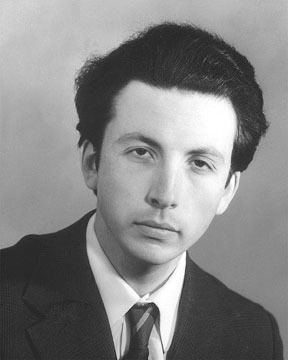Fields Mathematics | Name Vladimir Drinfeld Doctoral advisor Yuri I. Manin Role Mathematician | |
 | ||
Doctoral students Dmytro ArinkinDmitriy BoyarchenkoMasoud KamgarpourJoaquin Teruji Thomas Known for Quantum groupsGeometric Langlands correspondenceDrinfeld-Sokolov-Wilson equation Similar People Alexander Beilinson, Yuri I Manin, John Charles Fields | ||
Vladimir Gershonovich Drinfeld (Russian: Влади́мир Гершо́нович Дри́нфельд; born February 14, 1954), surname also romanized as Drinfel'd, is a Ukrainian mathematician currently working at the University of Chicago.
Contents
Drinfeld's work connected algebraic geometry over finite fields with number theory, especially the theory of automorphic forms, through the notions of elliptic module and the theory of the geometric Langlands correspondence. Drinfeld introduced the notion of a quantum group (independently discovered by Michio Jimbo at the same time) and made important contributions to mathematical physics, including the ADHM construction of instantons, algebraic formalism of the quantum inverse scattering method, and the Drinfeld–Sokolov reduction in the theory of solitons.
He was awarded the Fields Medal in 1990. In 2016, he was elected to the National Academy of Sciences.
Biography
Drinfeld was born in Kharkov, Ukrainian SSR, Soviet Union in 1954. In 1969, at the age of 15, Drinfeld represented the Soviet Union at the International Mathematics Olympiad in Bucharest, Romania, and won a gold medal with the full score of 40 points. He was, at the time, the youngest participant to achieve a perfect score, and has since only been surpassed by Sergei Konyagin (1972) and Noam Elkies (1981). Drinfeld entered Moscow State University in the same year and graduated from it in 1974. Drinfeld was awarded the Candidate of Sciences degree in 1978 and the Doctor of Sciences degree from the Steklov Institute of Mathematics in 1988. He was awarded the Fields Medal in 1990. Drinfeld moved to the United States in 1999 and has been working at the University of Chicago since January 1999.
Contributions to mathematics
In 1974, at the age of twenty, Drinfeld announced a proof of the Langlands conjectures for GL2 over a global field of positive characteristic. In the course of proving the conjectures, Drinfeld introduced a new class of objects that he called "elliptic modules" (now known as Drinfeld modules). Later, in 1983, Drinfeld published a short article that expanded the scope of the Langlands conjectures. The Langlands conjectures, when published in 1967, could be seen as a sort of non-abelian class field theory. It postulated the existence of a natural one-to-one correspondence between Galois representations and some automorphic forms. The "naturalness" is guaranteed by the essential coincidence of L-functions. However, this condition is purely arithmetic and cannot be considered for a general one-dimensional function field in a straightforward way. Drinfeld pointed out that instead of automorphic forms one can consider automorphic perverse sheaves or automorphic D-modules. "Automorphicity" of these modules and the Langlands correspondence could be then understood in terms of the action of Hecke operators.
Drinfeld has also done much work in mathematical physics. In collaboration with his advisor Yuri Manin, he constructed the moduli space of Yang–Mills instantons, a result that was proved independently by Michael Atiyah and Nigel Hitchin. Drinfeld coined the term "quantum group" in reference to Hopf algebras that are deformations of simple Lie algebras, and connected them to the study of the Yang–Baxter equation, which is a necessary condition for the solvability of statistical mechanical models. He also generalized Hopf algebras to quasi-Hopf algebras and introduced the study of Drinfeld twists, which can be used to factorize the R-matrix corresponding to the solution of the Yang–Baxter equation associated with a quasitriangular Hopf algebra.
Drinfeld has also collaborated with Alexander Beilinson to rebuild the theory of vertex algebras in a coordinate-free form, which have become increasingly important to two-dimensional conformal field theory, string theory, and the geometric Langlands program. Drinfeld and Beilinson published their work in 2004 in a book titled "Chiral Algebras."
